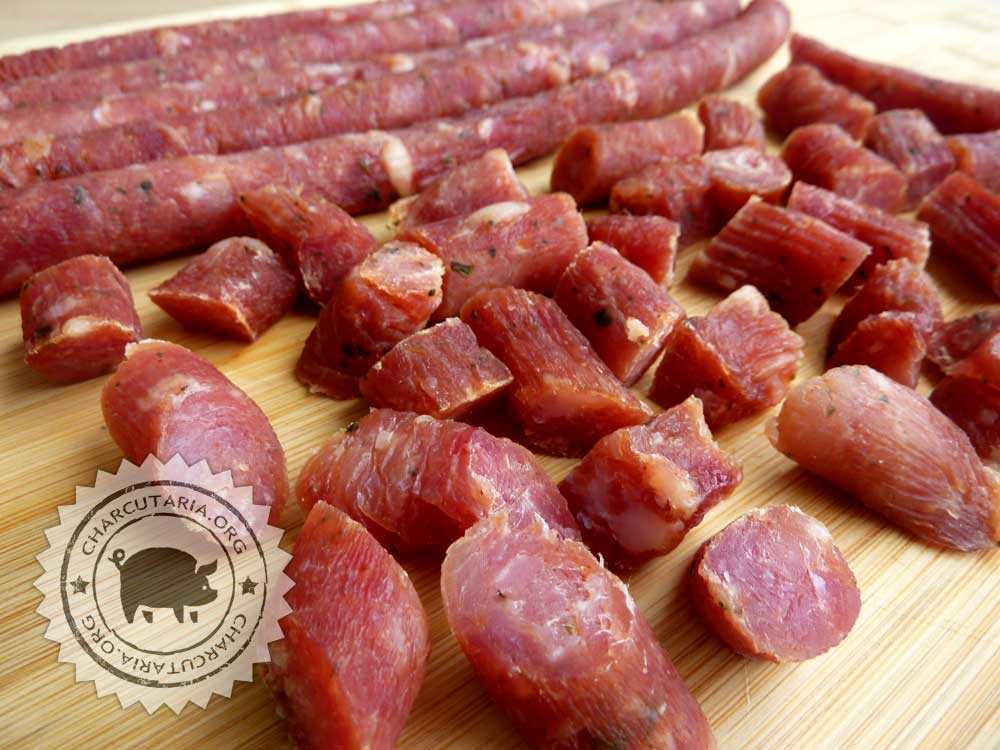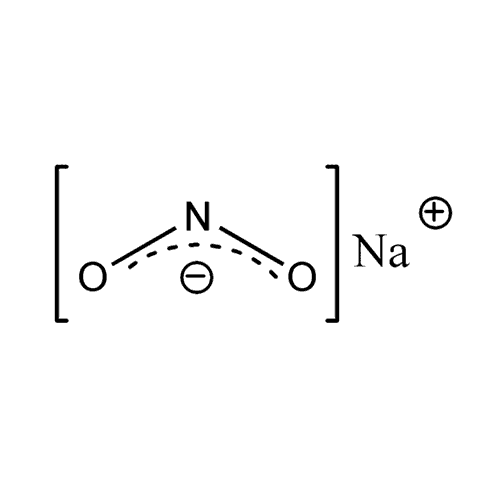
O aipo, por exemplo, contém nitratos, que nas condições corretas podem transformar-se em nitritos e auxiliar na cor, evitar rancidez e iniber patógenos anaeróbicos, como o Clostridium botulinum. A beterraba também pode ser usada para fins semelhantes, enquanto a cereja em pó contém antioxidantes e alta concentração de ácido ascórbico (vitamina C) que aumenta a taxa de óxido nítrico reduzida pelo nitrito, resultando em uma reação com a mioglobina e a transformação em nitrosil-hemocromo quando aquecido, fixando a coloração avermelhada típica das carnes curadas. Vinagre (ácido acético) e suco de limão também podem ser utilizados, uma vez que os ácidos acético e o cítrico mostram-se eficazes na prevenção do crescimento de bactérias, entre elas a Listeria monocytogenes.
Os vegetais em pó normalmente não são usados em embutidos, mas seu alto teor de nitratos os transformam em uma fonte natural importante destes compostos, com exemplos como aipo, couve, acelga, beterraba e cenoura. Esses ingredientes são utilizados de forma separada ou combinada para mascarar sabores desses vegetais, que não estão associados aos tradicionalmente encontrados nos embutidos.
O aipo em pó contém 3% de nitratos, o mesmo que a acelga em pó. Portanto, com a aplicação desses compostos, de forma separada ou combinada, com concentração de 0,4% na fórmula de um presunto, por exemplo, obtém-se 120 mg/kg de nitrato. Deve-se considerar que no processo de redução de nitrato para nitrito há uma perda de pelo menos 10%, a qual não é convertida em nitrito; e no processo de nitrificação e cozimento, pode-se perder de 10% a 20% a mais de nitrito final. Mesmo com essas perdas de nitritos, a concentração final de mais de 80 mg/kg de nitrito seria suficiente para obter a funcionalidade esperada dos nitritos no embutido.
Uma coisa importante a ser avaliada é que o nitrato de origem vegetal deve ser convertido em nitrito pois só o nitrito tem as funções desejadas. Para converter nitrato em nitrito são necessárias enzimas ou culturas starter redutoras de nitratos. Os micrococos e os estafilococos têm um sistema enzimático chamado nitrato redutase, e estas bactérias são utilizadas para esse fim. São utilizadas bactérias como o Lactobacillus curvatus, Lactobacillus sakei, Staphylococcus carnosus e/ou Staphylococcus xylosus. Micrococcus, Staphylococcus xylosus e Staphylococcus carnosus, que reduzem o nitrato em nitrito a temperaturas entre 15°C e 20°C, mas são muito mais eficientes sob temperaturas mais altas do que 30°C.
O uso de ácido ascórbico com concentração de 0,3% favorece a redução dos nitratos em nitritos, portanto, seu uso é recomendado. Além disso, o ácido ascórbico tem um alto poder antioxidante e mantém inalterável a coloração do presunto e dos outros embutidos.
Estudos sobre o uso de vegetais na cura natural
Aipo em pó
o aipo foi o primeiro vegetal utilizado como fonte de nitrato para a cura alternativa da carne. Desde o começo foi adicionado na forma de pó, mas os avanços da ciência levaram à melhoria desse produto. Um estudo investigou o efeito do aipo em pó micronizado (partículas menores do que 10 mícrons) na cura de linguiças suínas. Os diferentes tamanhos de partículas de ingrediente (265 μm, 68 μm e 7 μm) apresentaram diferentes resultados. Os pesquisadores relataram que o aipo em pó com partículas maiores foi mais eficiente na cura, ao passo que o pó com partículas menores tendeu a melhorar a oxidação das linguiças. Nenhum dos parâmetros de textura nas linguiças se viu afetado pelo tamanho de partícula dos pós de aipo;
Extrato de espinafre
Um estudo analisou o efeito de extratos de espinafre fermentado como fonte de nitrito pré-convertido no desenvolvimento da coloração de cura em fatias (2 cm de espessura) de lombos suínos. Os resultados mais significativos foram o desenvolvimento da coloração de cura e no grau de oxidação da gordura nas fatias de carne. Os valores de luminosidade e intensidade de amarelo das amostras com extrato de espinafre foram mais altos do que os das amostras de controle (com e sem nitrato). No entanto, os valores de intensidade de vermelho aumentaram nas amostras de carne curada cozida conforme aumentou o nível de extrato, ao passo que o amarelo reduziu na presença do aumento do nível de extrato. A oxidação (avaliada como valores de substâncias reativas de ácido tiobarbitúrico ou TBARS) das amostras com extrato de espinafre diminuiu com o aumento do percentual de extrato adicionado. Dessa forma, a carne curada com 30% de extrato de espinafre fermentado resultou em valores de TBARS mais baixos de todos os tratamentos (0,18±0,02 mg MA/kg) e somente ligeiramente mais altos do que o tratamento controle curado com nitrito (0,12±0,05 mg MA/kg). Além disso, as contagens de bactérias viáveis das amostras curadas com os extratos variaram de 0,34 a 1,01 Log UFC/g. Não se observaram nem E. coli nem bactérias coliformes em nenhuma das amostras curadas com extratos ou com nitrito (controle). Os pesquisadores concluíram que o extrato de espinafre fermentado pode ser adicionado a produtos cárneos para melhorar as características da cura;
Pó de rabanete
O rabanete tem um alto teor de nitratos (entre 1.878 e 6.260 ppm), bem como compostos bioativos como ácido ascórbico, polifenóis e flavonoides. Em um estudo, foram investigados os efeitos que diferentes concentrações de pó de rabanete teriam e os tempos de incubação acerca das propriedades físico-químicas e os pigmentos da carne curada de forma alternativa. O experimento se dividiu em sete grupos, com diferentes concentrações de pó de rabanete e diferentes tempos de incubação: controle (0,01% de nitrito de sódio), tratamento 1 (0,15% de pó de rabanete e 2 horas de incubação), tratamento 2 (0,15% de rabanete em pó e 4 horas de incubação), tratamento 3 (0,30% de rabanete em pó e 2 horas de incubação), tratamento 4 (0,30% de rabanete em pó e 4 horas de incubação), tratamento 5 (0,30% de aipo em pó e 2 horas de incubação) e tratamento 6 (0,30% de aipo em pó e 4 horas de incubação). Dentre as descobertas científicas, destaca-se o fato de que, embora a intensidade de vermelho não tenha sido significativamente diferente entre nenhum dos tratamento de cura alternativa e do controle com nitrito, aquelas amostras com 0,30% de pó de rabanete ou de aipo demonstraram um aumento no teor de nitritos, o de nitrosil-hemocromo e a eficiência da cura quando se aumentou o tempo de incubação de 2 para 4 horas. Dentre os produtos cárneos curados com pó de rabanete, o tratamento 4 demonstrou o maior aumento no teor de nitritos residuais, o teor de nitrosil-hemocromo e a eficiência de cura, mas demonstrou uma menor oxidação dos lipídios. Os resultados sugerem que o aumento das concentrações de pó de rabanete e os tempos de incubação mais longos seriam mais adequados para fabricar produtos cárneos curados de forma alternativa comparáveis com os produtos curados tradicionalmente tratados com nitrito sintético;
Solução de acelga
O teor médio de nitratos na acelga pode variar de 560 a 3.400 ppm, de acordo com pesquisas de diferentes fontes. Por isso, um estudo teve como objetivo analisar a possibilidade de uso de acelga pré-convertida como fonte de nitrito natural para a carne curada sem o acréscimo direto de nitrito de sódio. Na pesquisa, utilizou-se pó de acelga liofilizado, o qual foi obtido de um fornecedor no mercado local, diluído com água destilada, e a solução de acelga a 10% (p/v) foi incubada com uma cultura inicial comercial somente de Staphylococcus carnosus, a 37°C, durante 24 horas. Imediatamente depois da incubação, utilizou-se a solução de acelga, agora fermentada, para conseguir formar variadas salmouras e criar os diferentes tratamentos para curar lombos suínos. Dentre as descobertas científicas mais relevantes, os pesquisadores relataram que a oxidação dos lombos suínos, medida em níveis de ácido tiobarbitúrico, reduziu conforme aumentou o nível de fermentação de acelgas nas formulações; não foram encontradas diferenças significativas entre os tratamentos em relação a características sensoriais de sabor, mastigabilidade ou suculência, tampouco em relação à aceitação geral dos lombos suínos. No entanto, a coloração das amostras analisada aumentou significativamente com o aumento da concentração de fermentação de acelgas acrescentada aos lombos. Os pesquisadores concluíram que as acelgas utilizadas nesse formato (fermento) são uma alternativa viável para substituir o nitrito de sódio como agente de cura alternativo.
Referências
KIM, T.-K.; KIM, Y.-B.; JEON, K.-H.; PARK, J.-D.; SUNG, J.-M.; CHOI, H.-W.; HWANG, K.-E. & CHOI, Y.-S. Effect of fermented spinach as sources of pre-converted nitrite on color development of cured pork loin. Food Science of Animal Resources. vol. 37, n. 1, p. 105-113, 2017.
KIM, T.-K., HWANG, K.-E.; SONG, D.-H. et al. Effects of natural nitrite source from Swiss chard on quality characteristics of cured pork loin. Asian-Australasian Journal of Animal Sciences (AJAS). vol. 32, n. 12, p. 1933-1941, 2019.
RAMACHANDRAIAH, K. & CHIN, K. B. Antioxidant, antimicrobial, and curing potentials of micronized celery powders added to pork sausages. Food Science of Animal Resources. vol. 41 1, p. 110-121, 2021.
BAE, S. M.; CHOI, J. H. & JEONG, J. Y. Effects of radish powder concentration and incubation time on the physicochemical characteristics of alternatively cured pork products. Journal of Animal Science and Technology. vol. 62, n. 6, p. 922-932, 2020.





